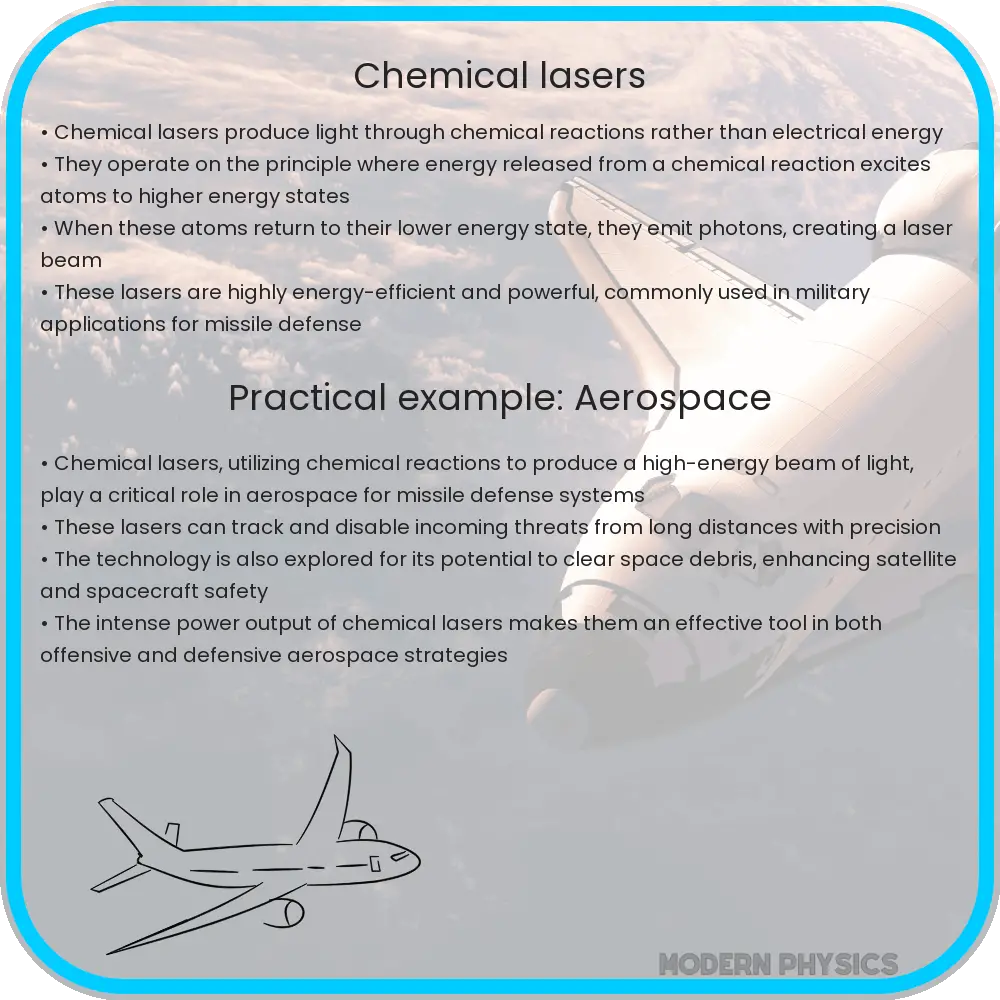Chemical lasers are a remarkable subclass of laser technology that derive their potency from exothermic chemical reactions. Unlike their solid-state or semiconductor counterparts, these lasers utilize the energy released during chemical reactions to excite molecules, leading to the emission of coherent light. This unique mechanism not only bestows upon them the ability to produce high power output but also equips them with specific characteristics that make them particularly appealing for applications within military domains. In this exploration, we delve into what chemical lasers are good for and why they have garnered such affection from military strategists.
What Are Chemical Lasers?
Before delving into their myriad applications, it is imperative to first elucidate the fundamental nature of chemical lasers. Generally characterized by their ability to generate light through the release of energy from chemical reactions, these lasers often leverage fuel and oxidizer pairs, such as hydrogen and oxygen, supplemented by dyes or other chemicals. The unique aspect of chemical lasers is their capacity to produce high-intensity beams of light very rapidly, often measured in megawatts, making them distinct within the broader landscape of laser technologies.
Historical Overview
The evolution of chemical lasers dates back to the mid-20th century, paralleling advancements in other areas of laser research. The emergent technologies were initially met with skepticism due to logistical concerns regarding their operation and safety. However, the efficacy of chemical lasers became apparent during the Cold War era when military applications began to surface. With escalating arms races, the need for potent and efficient weaponry surged, positioning chemical lasers as a formidable option.
Applications of Chemical Lasers in the Military
The military’s enthusiasm for chemical lasers can be attributed to their unique advantages, which cater ingeniously to tactical requirements. These applications can be broadly categorized into several domains:
- Weaponry: Chemical lasers have been propounded as tools for directed-energy weapons capable of engaging aerial threats, including drones and missiles. Their high power output allows for precise targeting, reducing collateral damage and enhancing combat effectiveness.
- Surveillance: The efforts to utilize chemical lasers extend to reconnaissance activities, where the beam can be employed to illuminate distant targets for imaging systems. The coherence of the light allows for fine resolution in imaging, thus delivering critical information in battlefield scenarios.
- Communications: Beyond traditional weapon uses, chemical lasers can also facilitate high-bandwidth communication. Given their capacity to produce focused beams over vast distances, they present a promising avenue for secure military communications, resisting interception from adversarial forces.
The Advantages of Chemical Lasers
The military’s affinity for chemical lasers stems from various advantages that these systems exhibit over conventional weaponry. These advantages include:
- Speed of Engagement: Chemical lasers offer near-instantaneous firing capabilities, allowing military personnel to respond to threats with unprecedented speed. This rapid engagement can be crucial during time-sensitive operations, distinguishing between mission success and failure.
- Cost-Efficiency: Once established, the operational costs associated with chemical lasers can be significantly lower than those tied to ammunition or traditional artillery. The module’s reliance on chemical reactants means that re-engagement is feasible, with substantial savings arising from reduced logistical burdens.
- Minimal Footprint: The unit design of chemical lasers can be compact, allowing for deployment in unconventional theaters without the associated mass of typical artillery systems. This versatility enables mobile operations and agile warfare.
The Technical Challenges: Are There Limitations?
Despite their advantageous attributes, the integration of chemical lasers into military applications is not devoid of challenges. There are significant hurdles that need to be addressed before they can realize their full potential:
- Handling and Safety Concerns: The toxic nature of some chemicals employed in these lasers poses substantial safety considerations. The management of hazardous materials and the necessity of rigorous safety protocols require an investment of time and resources.
- Environmental Sensitivity: Chemical lasers are often affected by atmospheric conditions, such as humidity or particulate matter, which can degrade beam quality. The efficiency of the weapons can thus be compromised, especially in adverse weather conditions.
Future Directions: What Lies Ahead?
The trajectory of chemical laser technology seems promising, as ongoing research endeavors seek to overcome current obstacles. Innovations actively targeting more stable chemical systems, enhancing beam quality, and optimizing safety protocols are underway. Furthermore, as military entities become increasingly cognizant of the need for definitive operational excellence amidst evolving warfare dynamics, chemical lasers may perform a pivotal role in various strategic frameworks, reinforcing their utility and significance.
Conclusion
In summation, chemical lasers represent an exquisite blend of chemistry and optics, engendering applications that resonate profoundly with military priorities. Their formidable power, coupled with distinct advantages and overarching versatility, illustrates why the military continues to invest in and develop this technology. As these systems march towards greater sophistication, they may catalyze a transformative era of warfare, characterized by precision, efficiency, and perhaps an ethical dialogue on the implications of such potent technologies. Consequently, as the pursuit for advanced weaponry persists, one must ponder: can the inherent advantages of chemical lasers reconcile with the complexities of modern warfare ethics? The challenge remains, making the future of chemical lasers not only a technological endeavor but a philosophical exploration.












